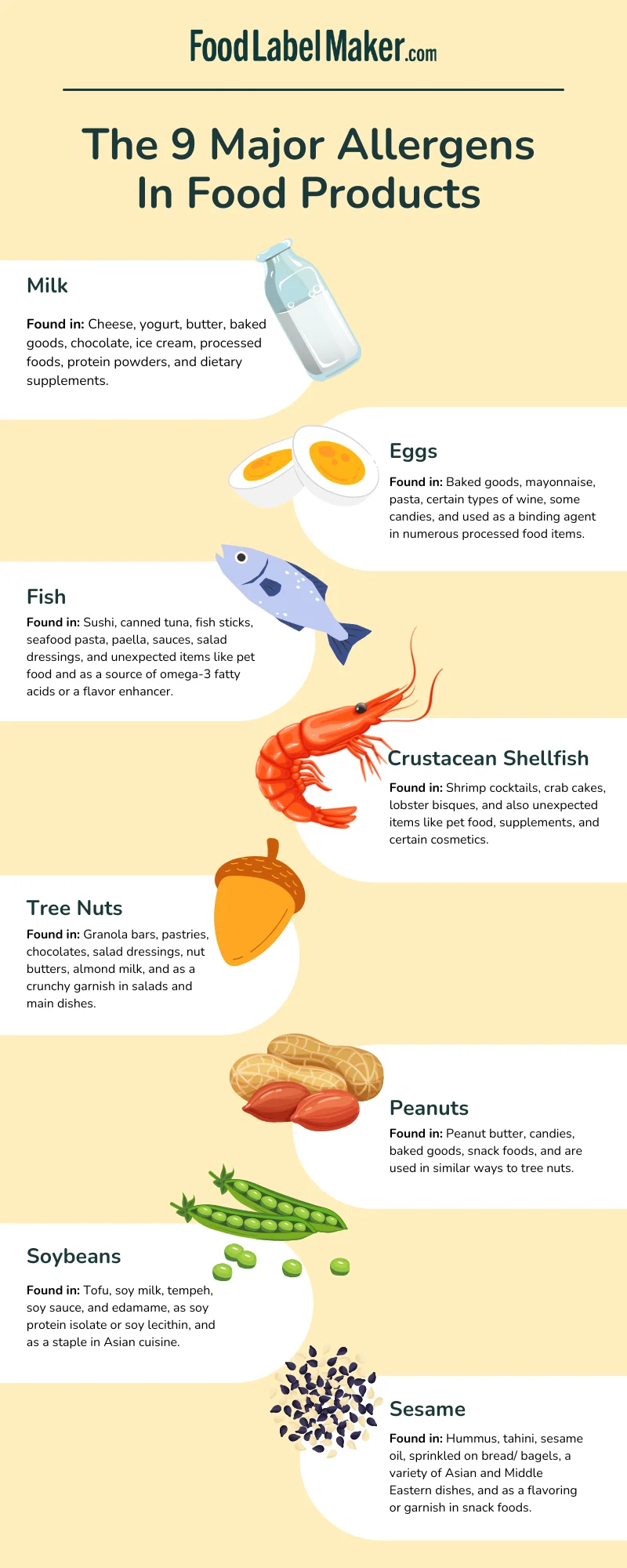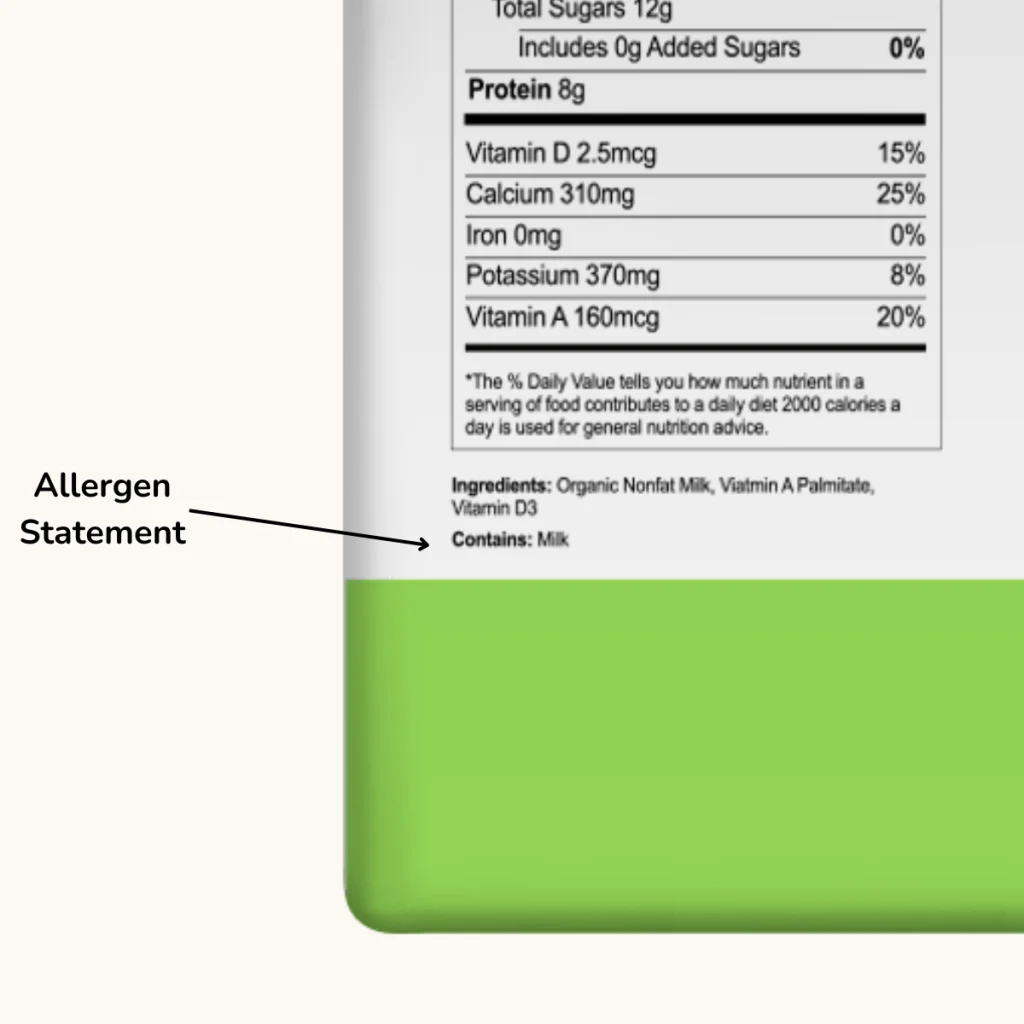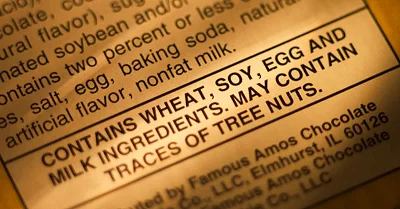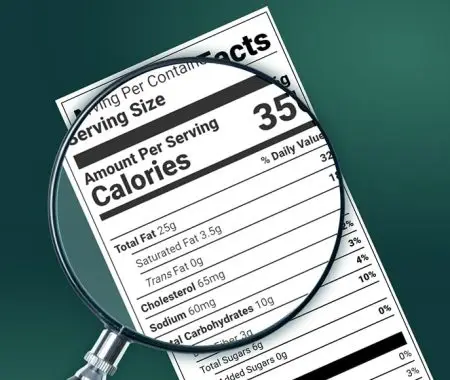Understanding the intricacies of food labeling, especially when it pertains to allergen statements, is crucial for both manufacturers and consumers. Ensuring that consumers are well-informed about potential allergens in products is not just a best practice—it’s a regulatory requirement.
This article aims to provide a comprehensive guide on the Food and Drug Administration (FDA) allergen statement requirements, helping you understand the nuances of labeling, disclaimers, and everything in between. With insights from trusted resources, we’ll delve deep into the guidelines set by the FDA and the importance of clear allergen labeling for consumer safety.
Summary
- Understanding food labeling for allergen statements is crucial.
- Clear allergen labeling is a regulatory requirement for consumer safety.
- FALCPA mandates clear allergen labeling on packaged food products.
- Two primary options for allergen declaration:
- Directly in the Ingredient List.
- Separate “Contains” Statement.
- Nine major allergens to be aware of, including the recently added sesame.
- Each allergen has various synonyms, species, and types.
- Crafting a compliant allergen label ensures consumer safety.
- Steps for creating a compliant label include identifying allergens, choosing a labeling method, ensuring visibility, and seeking expert advice.
- Addressing foods not listed under FALCPA but might cause reactions.
- Options for other foods include voluntary allergen labeling, “May Contain” statements, and consumer education.
- “May Contain..” declaration warns of potential cross-contamination.
- Consumers should always check labels due to potential changes in ingredients or production methods.
FALCPA and Their Requirements
The Food Allergen Labeling and Consumer Protection Act (FALCPA) is a critical piece of legislation that has set forth specific requirements for food manufacturers when it comes to allergen labeling. It requires that packaged food products clearly state the presence of any primary food allergens on the product’s packaging in straightforward terms.
With the recent inclusion of sesame in 2021 made by the Food Allergy Safety, Treatment, Education, and Research (FASTER) Act, there are now nine major allergens that manufacturers need to be particularly aware of. Each of these allergens can have various synonyms, species, and types, which makes accurate labeling all the more crucial.
To comply with FALCPA, manufacturers have two primary options:
- Ingredient List: Clearly mention the specific allergen in the ingredient list. For instance, if a product contains almond milk, the ingredient list should explicitly state “almond” as an ingredient.
- Contains Statement: Alternatively, after the ingredient list, manufacturers can use a “contains” statement to list out the allergens present. For example, “Contains: Almonds.”
By adhering to one of these options, manufacturers ensure transparency and safety for consumers who may have allergic reactions.
See How FoodLabelMaker Can Help You
The “Big 9” Allergens

Milk
Synonyms: Dairy, Butter, Cheese, Cream, Lactose, Whey, Curds, Casein
Species & Types: Cow’s milk, Goat’s milk, Sheep’s milk, Buffalo milk
Egg
Synonyms: Albumin, Globulin, Lecithin, Livetin, Lysozyme, Vitellin, Yolk
Species & Types: Chicken eggs, Duck eggs, Quail eggs, Goose eggs
Peanuts
Synonyms: Groundnuts, Monkey Nuts, Goobers.
Species: Arachis hypogaea.
Types: Runner, Virginia, Spanish, Valencia.
Tree Nuts
Synonyms: Almonds, Cashews, Walnuts, Hazelnuts, Pecans, Pistachios, and more.
Species: Various, depending on the specific nut.
Types: For instance, for almonds – Nonpareil, Carmel, Butte & Padre. Each nut type will have its own sub-varieties.
Wheat
Synonyms: Bran, Breadstuff, Cereal, Durum, Emmer, Semolina, Spelt, Farina.
Species: Triticum.
Types: Hard Red, Soft Red Winter, Hard White, Soft White.
Fish
Synonyms: Specific to the type of fish, e.g., Anchovy, Bass, Catfish, Salmon, Tuna, Mackerel, etc.
Species: Various, depending on the specific fish (Freshwater and Saltwater varieties).
Types: For instance, for salmon – Chinook, Coho, Sockeye, Atlantic, Pink.
Crustacean Shellfish
Synonyms: Crab, Lobster, Shrimp, Prawns, Crawfish
Species: Various, depending on the specific crustacean and region.
Types: For instance, for shrimp – Pink, Tiger, White, Brown.
Soy
Synonyms: Soya, Soybean, Edamame, Miso, Tempeh, Tofu.
Species: Glycine max.
Types: Black soybeans, green (edamame), yellow, and more.
Sesame
Synonyms: Benne, Gingelly, Til.
Species: Sesamum indicum.
Types: White, black, brown.
Each of these allergens has its own unique characteristics and can be found in various food products. It’s essential for manufacturers to be aware of these details to ensure accurate labeling and for consumers to recognize these terms when checking product ingredients. Proper food labeling is not just about compliance; it’s about ensuring the safety and well-being of consumers.
Building a Compliant Allergen Label Step-by-Step
Crafting a compliant allergen label is not just about adhering to regulations; it’s about ensuring the safety of consumers. Here’s a step-by-step guide to help you navigate the process and ensure your labels meet FALCPA requirements:
- Identify Allergenic Ingredients: Begin by listing all the ingredients in your product. Identify which ones are allergens or derived from allergenic sources.
- Choose a Labeling Method: As aforementioned, for FALCPA compliance, you have two primary methods to indicate allergens:
- Directly in the Ingredient List: You can specify the allergen right after the ingredient name, using parentheses. For instance: Peanut butter (peanuts), casein (milk), or spice (sesame).
- Separate “Contains” Statement: Alternatively, you can use a distinct “Contains” statement after the ingredient list. For example: Contains peanuts, milk, and sesame.
- Ensure Visibility: The allergen information should be easily visible, using a font size and style that stands out from the rest of the label.
- Review Synonyms: Some allergens might have other names or synonyms. Ensure you’re using the most recognizable name for clarity.
- Update Regularly: If there are changes in your product formulation or if new allergens are recognized by the FDA, update your labels promptly.
- Educate Your Team: Ensure everyone involved in the product formulation and labeling process is aware of the allergen labeling requirements.
- Seek Expert Advice: When in doubt, consult with experts or legal counsel to ensure your labels are compliant. Companies such as Food Label Maker have an array of nutrition experts who can assist you in identifying any allergens present in your food product or ingredient list.
Use your very own checklist to ensure that you have followed all the necessary steps to creating a compliant nutrition label. Click here for this resource.
What To Do About Other Foods That May Cause Reaction
While FALCPA focuses on the primary allergens responsible for most allergic reactions, there are countless other foods and ingredients that might cause adverse reactions in some individuals. Here’s what you can do:
- Voluntary Allergen Labeling: Even if an ingredient isn’t one of the primary allergens identified by FALCPA, you can still choose to highlight it on your label if you believe it’s relevant for your consumers.
- “May Contain” Statements: If there’s a chance of cross-contamination in your production process, consider using statements like “May contain traces of [allergen]” to inform consumers.
- Educate Consumers: Use your product’s website or other marketing materials to provide more detailed information about allergens and your manufacturing process.
- Stay Updated: New research is continually emerging about food allergies. Stay informed about the latest findings to ensure you’re providing the most accurate information to your consumers.
- Feedback Channels: Allow consumers to reach out with their concerns or reactions. This feedback can be invaluable in identifying potential issues and improving your labeling practices.
Precautionary Labelling: The “May Contain..” Declaration
Precautionary labeling, often recognized by the familiar “May Contain..” declaration, serves as a warning to consumers about the potential presence of allergenic ingredients due to cross-contamination. While these labels are voluntary, they play a crucial role in informing consumers about potential risks, especially those with severe allergies.
The “May Contain..” declaration is not about the deliberate inclusion of an ingredient but rather the unintentional inclusion due to shared equipment, production lines, or handling practices. For instance, a product made on the same equipment as a peanut-containing product might have a “May Contain peanuts” label, even if peanuts aren’t an intentional ingredient.
However, it’s essential to use this declaration responsibly. Overusing precautionary labels can dilute their significance and potentially limit the choices available to allergy sufferers. It’s crucial to base these warnings on a genuine risk of cross-contamination, backed by thorough risk assessments.
Examples of Proper Allergen Labeling


Understanding allergen labeling is one thing, but visualizing it can provide clarity. Here are some examples of proper allergen labeling:
- Bolded Ingredients in the List: A product’s ingredient list might have allergens bolded to make them stand out. For instance, “Ingredients: Water, Peanuts, Salt, Sugar.”
- Parenthetical Information: After an ingredient, its allergenic source is mentioned in parentheses. Example: “Ingredients: Enzyme (from milk), Natural Flavors.”
- Separate ‘Contains’ Statement: At the end of the ingredient list, a clear ‘Contains’ statement highlights the allergens. Example: “Contains: Wheat, Egg, and Soy.”
- Icons or Symbols: Some labels use icons or symbols, like a small image of a peanut or a milk carton, next to the ingredient list to visually represent the allergens present.
- Precautionary Labeling: Beneath the ingredient list, a “May Contain..” statement warns of potential cross-contamination. Example: “May contain traces of tree nuts.”
When browsing products, consumers should always check the label, even if they’ve purchased the item before. Manufacturers can change ingredients or production methods, which might alter the allergen information. Therefore, proper allergen labeling, combined with consumer vigilance, ensures safety and confidence in food choices.



